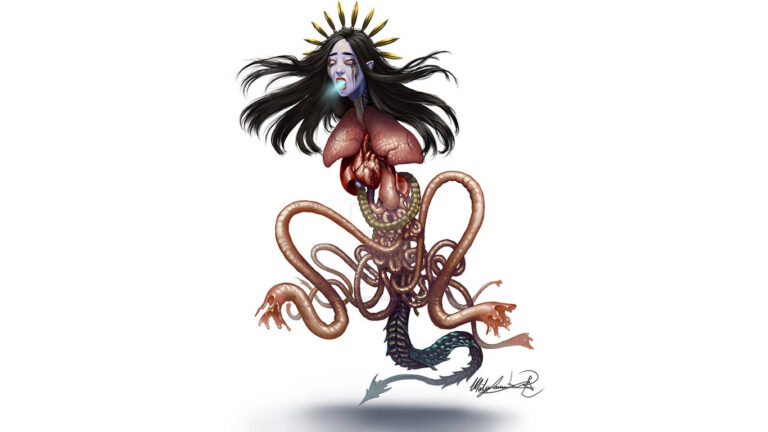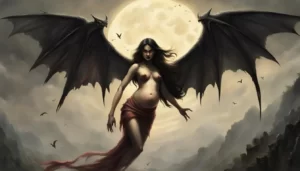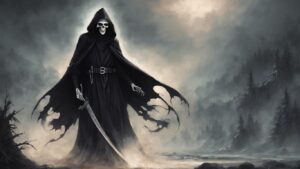Table of Contents
The Krasue is typically depicted as a floating head with internal organs, such as the heart, lungs, and entrails, hanging down from the neck. It is said to fly through the air, usually at night, with its internal organs glowing in the dark. The creature is often portrayed as a female spirit.
According to various legends, the Krasue was once a beautiful woman who practiced black magic or committed some other heinous act, resulting in a curse that transformed her into this monstrous form. The Krasue is said to have an insatiable hunger for blood, and it preys on animals and sometimes even humans while they sleep.
To protect themselves from the Krasue, people in these regions often follow traditional rituals, use amulets, or perform ceremonies to ward off these malevolent spirits. The Krasue legend has also been adapted into various movies, television shows, and literature, contributing to its popularity in modern popular culture.
Origin

The origin of the Krasue legend is rooted in Southeast Asian folklore, and while variations exist, the creature is most commonly associated with Thai, Cambodian, and Laotian mythology. The exact origin story can vary, as folklore often evolves and takes on different forms over time.
In general, the Krasue is believed to have been a woman who practiced dark magic, committed sinful acts, or was cursed in some way. As a punishment for her deeds, she is transformed into a grotesque, floating head with dangling internal organs. The specifics of her origin can differ from one regional or cultural variation of the myth to another.
Despite the differences in the tales, a common theme is the Krasue’s nocturnal activities, with the creature often said to emerge at night to feed on the blood of animals or humans. This aspect of the legend contributes to the fear associated with the Krasue, as it is believed to be a malevolent spirit that poses a threat to those it encounters.
Over the years, the Krasue legend has become deeply ingrained in the cultural fabric of the regions where it is prevalent. It has been passed down through generations via oral traditions and has become a popular subject in literature, film, and other forms of popular culture in Southeast Asia.
Physical Description
The Krasue is typically described as a horrifying and supernatural creature with a distinctive physical appearance. While there can be some variations in the details based on regional folklore, a common depiction includes the following features:
Floating Head: The Krasue is often described as a floating head that appears disembodied, detached from the rest of the body. This floating head is capable of moving independently from the body.
Internal Organs: One of the most striking features of the Krasue is the sight of its internal organs hanging down from the neck. These organs typically include the heart, lungs, and entrails. In some variations, the internal organs are said to emit a faint, eerie glow.
Female Appearance: The Krasue is often portrayed as a female spirit or ghost. The reasons for the transformation into a Krasue may vary, but it is often associated with a woman who committed evil deeds, practiced black magic, or was cursed.
Nocturnal Behavior: The Krasue is said to be active primarily at night, adding to the supernatural and frightening nature of the creature. It is believed to roam the darkness in search of blood to satisfy its insatiable hunger.
The unsettling combination of a floating head, dangling internal organs, and a nocturnal predatory nature contributes to the fear and mystique associated with the Krasue. It is important to note that specific details of the physical appearance may vary based on cultural interpretations and regional variations of the myth.
Personality
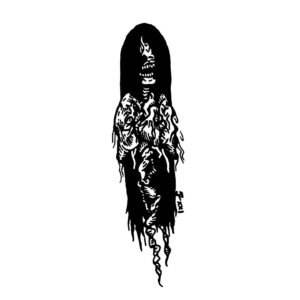
The Krasue is typically portrayed as a malevolent and vengeful entity in Southeast Asian folklore. While the specific personality traits attributed to the Krasue can vary based on different regional variations of the myth, some common themes include:
Malicious Intent: The Krasue is often depicted as harboring ill will toward the living. It is said to be driven by a hunger for blood, and it may prey on animals or even humans while they sleep. This predatory behavior contributes to the fear associated with the creature.
Cursed or Vengeful Origin: In many versions of the Krasue legend, the creature’s transformation is the result of a curse or punishment. The backstory often involves a woman who engaged in forbidden practices, black magic, or committed sinful acts, leading to her transformation into the Krasue. This backstory may suggest a vengeful or cursed nature.
Haunted Existence: The Krasue is sometimes portrayed as a tormented spirit trapped in its monstrous form, compelled to roam the night in search of sustenance. This adds a layer of tragedy to its character, as it is often a victim of supernatural consequences for its past actions.
Stealthy and Elusive: The Krasue is commonly associated with the night, and its nocturnal activities make it a stealthy and elusive creature. It is said to move silently through the darkness, heightening the element of fear surrounding its presence.
While the Krasue is primarily known for its frightening and predatory nature, the specific details of its personality can vary, and storytellers may adapt the myth to fit different cultural contexts and narratives. Overall, the Krasue is a creature that instills fear and is often used as a cautionary tale in Southeast Asian folklore.
Explanation of the Myth
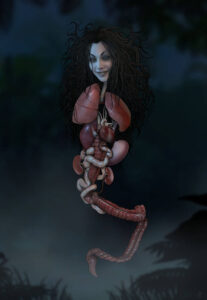
The Krasue myth is deeply rooted in Southeast Asian folklore, particularly in Thailand, Cambodia, Laos, and parts of Malaysia. The myth typically revolves around the transformation of a woman into a malevolent and supernatural entity known as the Krasue. While variations exist, the core elements of the myth include the following:
The Transformation:
Origin of the Curse: The Krasue is often believed to be a woman who, due to engaging in forbidden practices, committing sinful acts, or practicing black magic, becomes the target of a curse. This curse results in her transformation into the monstrous form of the Krasue.
Floating Head with Organs: The central and most iconic aspect of the Krasue’s appearance is its floating head. The head is detached from the body, and it is accompanied by internal organs—typically the heart, lungs, and entrails—hanging down from the neck.
Nocturnal Predator:
Nighttime Activities: The Krasue is primarily active during the night, adding an element of fear and mystery to its character. It is said to emerge after dark to hunt for blood, and its nocturnal nature contributes to its reputation as a fearsome creature.
Bloodthirsty Nature: The Krasue is known for its insatiable hunger for blood. It preys on animals and sometimes humans, seeking to satisfy its cravings during its nightly excursions.
Cursed Existence:
Haunted by Past Deeds: The Krasue is often depicted as a tormented and cursed entity, haunted by its past actions. The transformation into this monstrous form is considered a punishment for engaging in activities deemed taboo or morally wrong.
Trapped in Monstrous Form: The Krasue is trapped in its monstrous form, unable to escape the consequences of its past. This adds a tragic element to the myth, portraying the creature as both a victim and a source of fear.
Protective Measures:
Rituals and Amulets: Communities in the regions where the Krasue myth is prevalent often have traditional rituals and practices to ward off the creature. This may include the use of protective amulets or ceremonies aimed at keeping the Krasue at bay.
Cultural Significance:
Cautionary Tale: The Krasue myth serves as a cautionary tale, warning against engaging in forbidden or morally questionable activities. It reinforces societal norms and values, emphasizing the consequences of straying from accepted behavior.
Cultural Adaptations: Over time, the Krasue myth has been adapted into various forms of popular culture, including literature, film, and art, further embedding its presence in the cultural consciousness of the regions where it is prevalent.
Overall, the Krasue myth weaves together elements of horror, morality, and supernatural consequences, creating a narrative that has endured through generations in Southeast Asian folklore.
In Modern Usage and Symbolism
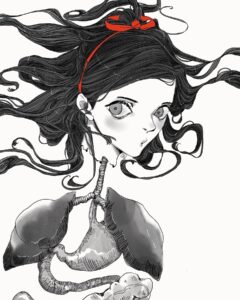
In modern usage and popular culture, the Krasue has continued to be a prominent figure, particularly in Southeast Asia. It has become a symbol of horror, and its influence can be observed in various forms of media, entertainment, and cultural expressions. Here are some ways the Krasue is used in modern contexts:
Horror Films and Literature:
The Krasue has been featured in numerous horror films, both traditional and contemporary, across Southeast Asia. These films often use the creature as a central element to evoke fear and suspense.
Television and Pop Culture:
The Krasue has made appearances in television shows and series, contributing to its presence in popular culture. It may be adapted and reimagined to fit different genres and storytelling formats.
Art and Visual Representations:
Artists may incorporate the imagery of the Krasue in their works, whether in traditional paintings, digital art, or other forms of visual expression. Its distinctive appearance makes it a compelling subject for artistic interpretation.
Literary Adaptations:
The Krasue myth has been adapted into modern literature, including novels and short stories. Authors may use the creature as a symbol or explore its themes in a contemporary context.
Video Games:
The Krasue has found its way into video games, where it may serve as a formidable adversary in horror-themed games. Its supernatural and menacing characteristics make it a fitting creature for game developers aiming to create suspenseful experiences.
Cultural Events and Festivals:
In some regions, the Krasue may be incorporated into cultural events or festivals, further emphasizing its significance in the local folklore. This can include theatrical performances, parades, or exhibitions.
Symbolism and Morality:
The Krasue continues to symbolize morality and the consequences of wrongdoing. In modern contexts, it may be used as a metaphor for the enduring impact of one’s actions and the idea that past deeds can come back to haunt an individual.
Commercial Products:
The imagery of the Krasue may be utilized in commercial products, such as merchandise or advertisements, to capitalize on its popularity in the horror genre.
Tourism and Cultural Promotion:
Some regions may incorporate the Krasue myth into tourism efforts or cultural promotion, using it as a unique and intriguing aspect of local folklore to attract attention and interest.
Krasue’s continued presence in modern usage reflects its enduring status as a captivating and frightful figure deeply embedded in the cultural consciousness of Southeast Asia. It serves not only as a source of entertainment but also as a cultural symbol with roots in traditional folklore.
Related Creatures
The Krasue is part of a broader category of supernatural and mythical creatures found in various cultures around the world. While the specifics of these creatures can vary significantly, there are some entities with similarities to the Krasue in terms of their supernatural and often malevolent nature. Here are a few examples:
Penanggalan (Malaysia, Indonesia):
Similar to the Krasue, the Penanggalan is a Southeast Asian mythological creature. It is often depicted as a detached female head with trailing organs, and it shares the characteristic of being a nocturnal bloodsucker. The Penanggalan is known to detach its head from its body to hunt for blood.
Leak (Bali):
The Leak is a Balinese mythological creature with characteristics similar to the Krasue. It is believed to be a witch who can detach her head and organs to transform into a supernatural being at night, seeking blood to maintain her powers.
Churels (India):
In Indian folklore, the Churel is a vengeful female spirit. Like the Krasue, Churels are often associated with the spirits of women who died during childbirth or under tragic circumstances. They are said to appear as beautiful women to lure victims before revealing their true, terrifying form.
Manananggal (Philippines):
The Manananggal is a mythical creature in Philippine folklore. It is typically depicted as a woman who can separate her upper torso from her lower body, with bat-like wings. Like the Krasue, the Manananggal is known for its nocturnal activities, feeding on the blood of pregnant women.
Noppera-bo (Japan):
While not directly similar in appearance, the Noppera-bo is a Japanese yōkai (supernatural creature) that can take on a human appearance but lacks facial features. It shares a theme of supernatural entities with eerie characteristics.
Liderc (Hungary):
The Liderc is a creature in Hungarian folklore that can transform into various forms, including a beautiful woman or a fireball. It may have vampiric qualities and is known for causing harm to humans.
These creatures from different cultures share common themes such as supernatural transformations, nocturnal activities, and a connection to blood or life force. While their specific attributes and cultural contexts vary, they all contribute to the rich tapestry of global mythology and folklore.
FAQ
Who is Krasue?
Krasue is a mythical creature in Southeast Asian folklore, particularly in Thailand, Cambodia, Laos, and parts of Malaysia. It is often depicted as a floating head with internal organs, such as the heart and entrails, hanging down from the neck. The creature is associated with supernatural and nocturnal activities, including a thirst for blood.
Is Krasue good or bad?
Krasue is generally portrayed as a malevolent and vengeful entity. It is known for its predatory nature, feeding on the blood of animals and sometimes humans. In folklore, the transformation into a Krasue is often considered a consequence of engaging in forbidden practices or committing sinful acts.
What happened to Krasue?
The Krasue is believed to be a woman who, due to engaging in black magic, committing sins, or being cursed, undergoes a supernatural transformation into the monstrous form of the Krasue. The specific details of the transformation can vary in different cultural variations of the myth.
Who means Krasue in the Thai language?
In Thai language, "Krasue" (กระสือ) refers to the mythical creature described above.
How to say Krasue?
The word "Krasue" is pronounced as /krà-sʉː/ in Thai.
How does Krasue kill people?
In folklore, Krasue is said to feed on the blood of living beings, often animals or humans, while they sleep. The creature is depicted as having a voracious appetite and may use its fangs to bite and consume blood.
What is the real story of Krasue?
The Krasue myth is a piece of folklore and not based on historical events. It typically involves the transformation of a woman into a Krasue as a consequence of her actions, such as practicing dark magic or committing sins.
What happened to Krasue's eyes?
In the traditional depiction, the Krasue is often portrayed with its eyes intact, but it varies in different cultural interpretations and artistic representations. The emphasis is usually on the floating head with internal organs.
What does Krasue eat?
Krasue is said to have a strong desire for blood. It feeds on the blood of animals or humans, using its fangs to bite and consume the blood while they sleep. The creature is often associated with nocturnal activities, hunting for sustenance in the darkness.
